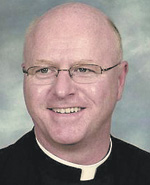(See the readings for the First Sunday of Lent, March 9)
“Jesus was led by the Spirit into the desert to be tempted by the devil.” Three elements of this opening verse of today’s Gospel passage deserve attention as we begin the season of Lent. They are “led by the Spirit,” “into the desert” and “to be tempted by the devil.”
First, Jesus is led by the Spirit to the desert and to the place of temptation. The Spirit is active in Jesus’ ministry and is directing Jesus on the path ahead. The Spirit helps unfold the public ministry that lies ahead of Jesus. It is the same Spirit who was present in the creation of the world.
Recall in the first creation account that the image used to describe the creation of the world was God speaking. As he speaks, breath comes out and carries his Word. (The word “spirit” comes from the Latin word for “breath.”) The world is created through this Word. In the second creation account, when God creates man, he “blew into his nostrils the breath of life, and the man became a living being.” The breath is the spirit moving and present, who shares life with man. The same Spirit is now leading Jesus into the desert.
[hotblock]
Second, the Spirit directs Jesus into the desert. The desert is the place of desolation and extremes. The nights are cold and the days are hot. Vegetation and water are scarce. Wild animals roam at night. Shelter is hard to find. Living in the desert places one at risk, risk of hunger, risk of thirst, risk of life. It is a dangerous place. Thinking back to the second account of creation again, we might think of a contrast between a desert and the Garden of Eden, which is described as a lush and fertile land with much food and life. The contrast between death and danger, life and security, is quite strong. The Spirit is leading Jesus not into the garden but into the desert. It is in this desert, which in one sense represents all that the garden is not, where Jesus will be tempted.
Third, Jesus is tempted by the devil in the desert. Three times Satan tempts Jesus. The first reading for today’s liturgy is the account of the fall of man. Here the devil tempts Adam and Eve and they succumb to the temptation. The devil, or Satan, is represented by the serpent. The biblical author describes him as “the most cunning of all the animals.”
 The description holds true for Jesus’ temptation as well. Adam and Eve were tempted to become “like gods” by eating the fruit of the tree of the knowledge of good and evil.
The description holds true for Jesus’ temptation as well. Adam and Eve were tempted to become “like gods” by eating the fruit of the tree of the knowledge of good and evil.
Jesus is now tempted, not once but three times. In each temptation Satan attempts to have Jesus assert, in some way or another, power or control over his Father. The devil begins by capitalizing on Jesus’ hunger (due to the fasting for 40 days and nights). He tempts Jesus to provide food for himself by turning stones into bread and thereby demonstrate his authority as Son of God. Jesus rebukes the temptation quoting Scripture and his reliance on the Father: “One does not live by bread alone, but on every word that comes forth from the mouth of God.”
The devil again tries to tempt Jesus to demonstrate his power over his Father. This time Satan uses Scripture to entice Jesus, to which Jesus replies quoting scripture: “You shall not put the Lord, your God, to the test.”
The final temptation is more blunt. The devil offers Jesus all worldly power and authority and splendor if Jesus would worship him. At this point Jesus dismisses Satan saying: “Get away, Satan! It is written: The Lord, your God, shall you worship and him alone shall you serve.” Jesus overcomes the temptations and remains sinless before his Father.
The temptation scene represents the beginning of the transformation of man. St. Paul reminds us, in the second reading, of the transformation by contrasting Jesus with Adam. Adam sins and death comes to all men. Jesus remains obedient to the Father and through him “many will be made righteous.”
The faithfulness of Jesus to the Father lies at the core of the temptation account. Jesus remains faithful even under such dire circumstances. Despite the conditions of the desert climate and desolation, despite the hunger and bodily weakness that result from the fasting, Jesus remains faithful.
If we view this in terms of a conflict with evil, represented by Satan, the conflict will heighten all the way to its climax at the passion and crucifixion of Jesus. In this ultimate confrontation, Jesus will remain obedient to the Father and through this obedience and faithfulness he will redeem all mankind. His obedience rectifies the disobedience of the first man. His resurrection will restore life where there once was death – this is the “gracious gift” which St. Paul describes. Jesus is the gift of life for all.
Today is the First Sunday of Lent. We began our Lenten journey a few days ago when ashes were marked on our foreheads or sprinkled on our heads. The symbolic gesture reminds us that we are in a season of penitence. The season has been described many ways. One way is that it is a time in the desert. Jesus went into the desert to be tempted and through that temptation to be strengthened for the ministry that lay ahead.
As we take up the penitential practices of prayer, fasting and almsgiving we too enter the desert. We are afforded the opportunity to become weak so that our faith in the Father’s providential love and care can become heightened in our lives. As we follow in the footsteps of Jesus we become more and more aware of the great gift he is to us, the great love he has for us and the strength that comes from faith in our heavenly Father. Following in the footsteps of Christ as we are led to the passion, death and resurrection we grow in our appreciation and thankfulness for Christ Jesus and the life we share through him. Inevitably we become more aware of our own sinfulness in the face of Jesus’ faithfulness and we humbly yet confidently cry out like the psalmist: “Have mercy on me, O God, in your goodness; in the greatness of your compassion wipe out my offense. Thoroughly wash me from my guilt and of my sin cleanse me.”
***
Msgr. Joseph Prior is pastor of St. John the Evangelist Parish, Morrisville.
PREVIOUS: Readings for the holy Mass – First Sunday of Lent
NEXT: Praying Lent: Friday after Ash Wednesday




Share this story